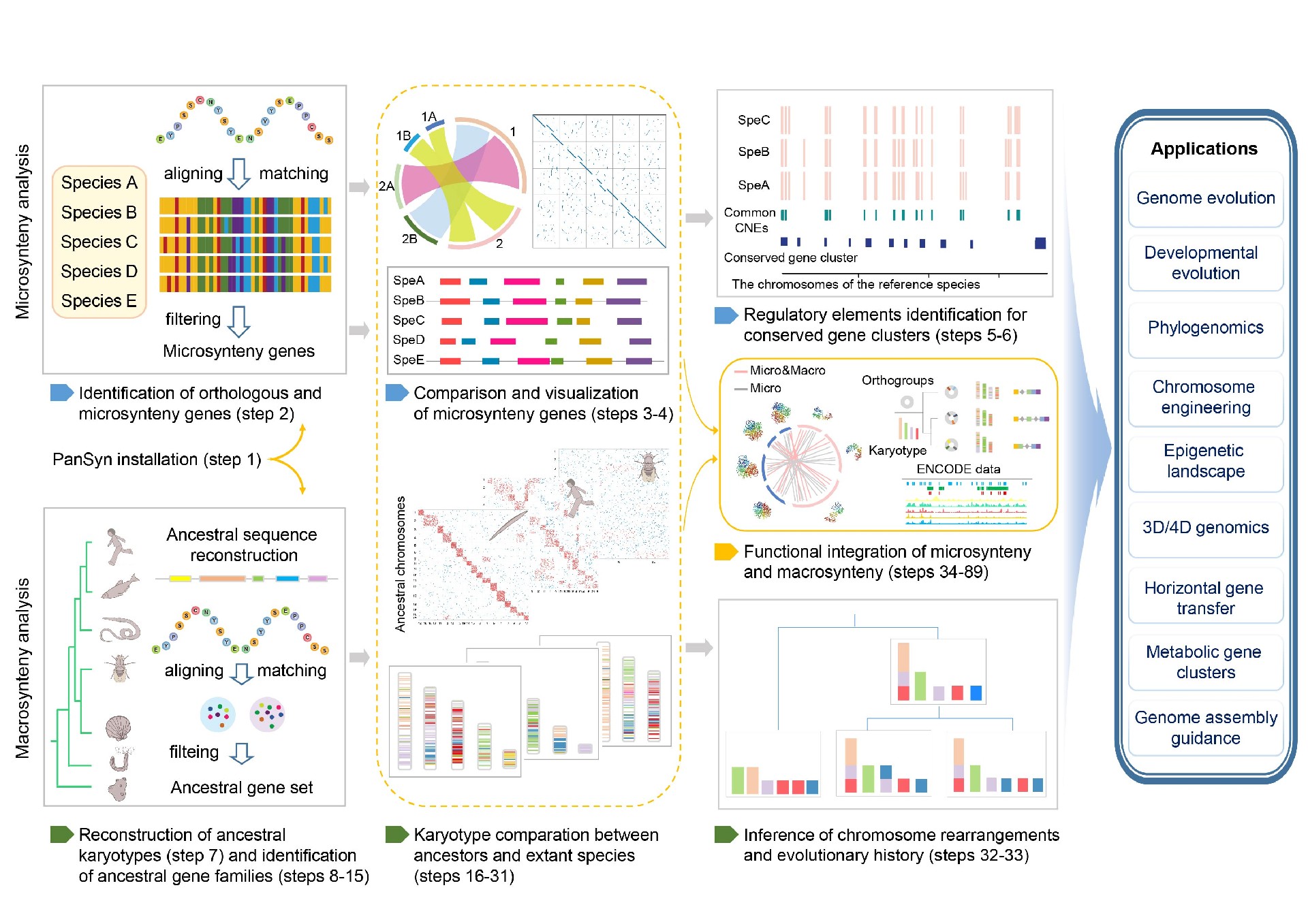
Lab achieves significant progress in developing genomic systematic analysis tools
On March 21, 2024, our research group achieved a major milestone in the development of genomic systematic analysis tools, launching PanSyn, the world's first comprehensive analysis tool that integrates both macro and micro-evolutionary genomics and functional genomics datasets. This significant progress was extensively detailed in a 68-page paper in Nature Protocols under the title "Pan-evolutionary and regulatory genome architecture delineated by an integrated macro- and microsynteny approach." This achievement is a culmination of the team's long-term accumulation of extensive experience in genomic analysis methods and tool development.
Deciphering the structure and function of genomes is crucial for understanding Earth's life history and biodiversity. Revolutionary breakthroughs in high-throughput sequencing and the widespread application of various omics technologies have brought unprecedented development opportunities to the life sciences, propelling research into the big data era. Initiatives like the Earth BioGenome Project aim to profile millions of high-quality reference genomes within a decade, advancing the goal of decoding the Tree of Life. Deep mining of complex, high-dimensional omics resources has become a significant challenge, particularly as most biological groups, especially non-model marine organisms, lack comprehensive genomic analysis tools, making it difficult to analyze increasingly complex omics data.
Genome synteny refers to the conserved collinearity correspondence of genomic or gene blocks from two or more genomes either at chromosomal (macrosynteny) or subchromosomal scales (microsynteny). Genomic synteny analysis provides a fundamental framework for comparative genomics, playing a key role in elucidating genome structure, regulatory elements, and evolutionary history. Recent decades have seen numerous significant discoveries and breakthroughs in biology through microsynteny/macrosynteny analysis, such as vertebrate genome duplication events, reconstruction of ancestral karyotypes, and the regulatory role of Hox gene clusters in body axis development. However, most synteny analysis methods are either focused on micro-evolutionary scales or are limited to single evolutionary scales, lacking comprehensive analysis across both scales, which impedes a full understanding of the genome's pan-evolutionary processes and functional significance. Therefore, there is an urgent need for a comprehensive and systematic comparative genomics analysis tool.
In response to these global challenges in genomics, our team developed PanSyn, the most comprehensive and systematic tool for integrating macro/micro-evolutionary genomics and functional genomics datasets to date. This tool not only encompasses a fully-functional microsynteny analysis module but also significantly addresses the gap in macrosynteny analysis tools, offering an innovative integrated analysis module that combines micro and macro synteny with regulatory omics data. Compared to mainstream software and tools, PanSyn exhibits significant advantages in several aspects: 1) For microsynteny, it offers comprehensive analysis of various scenarios including single to multiple comparisons, simple to complex polyploidy, low to high-dimensional networks, and genomic structure to gene function. 2) For macrosynteny, it facilitates analysis of ancestral genome reconstruction, ancient gene family clustering, karyotype conservation estimation, and systematic inference of chromosomal evolutionary processes. 3) In the integrated analysis module, it introduces for the first time a dual integration strategy from micro to macro (bottom-up) and from macro to micro (top-down), enabling systematic inference and analysis of the pan-evolutionary scale between ancestors and extant species. This integration also encompasses multi-dimensional functional omics data, providing a more comprehensive and in-depth functional perspective for understanding genome evolution. Our research group has provided detailed protocol and application demonstrations for PanSyn, whose highly customizable features meet the specific analysis needs of various species or groups.
PanSyn is the first tool in the world to integrate comprehensive analysis of macro/micro-evolutionary and functional genomics. It offers a powerful tool for decoding genome evolution and function, facilitating the development and utilization of genetic resources, and promoting innovative discoveries and significant breakthroughs in the life sciences, ultimately contributing to a complete understanding of the evolutionary trajectory of the Tree of Life.

Figure 1. Overview of the integrated analysis tool PanSyn for macro/micro evolutionary genomics and functional genomics.
Professors Shi Wang and Yuli Li of the Key Laboratory of Marine Genetics and Breeding (Ministry of Education), and the Center for Marine Biology Evolution and Development led by Fang Zongxi, serve as co-corresponding authors of the paper, with doctoral students Hongwei Yu and Professor Yuli Li as co-first authors. This research was supported by Laoshan National Laboratory, the National Natural Science Foundation of China, the National Key R&D Program, the Shandong Provincial Key R&D Program, and the Taishan Scholar Program.
Full paper link:
The links to relevant key research papers:
Nature Protocols & Methods Community — Behind the Paper:
PanSyn: Elucidation of Pan-evolutionary and Regulatory Genome Architecture

